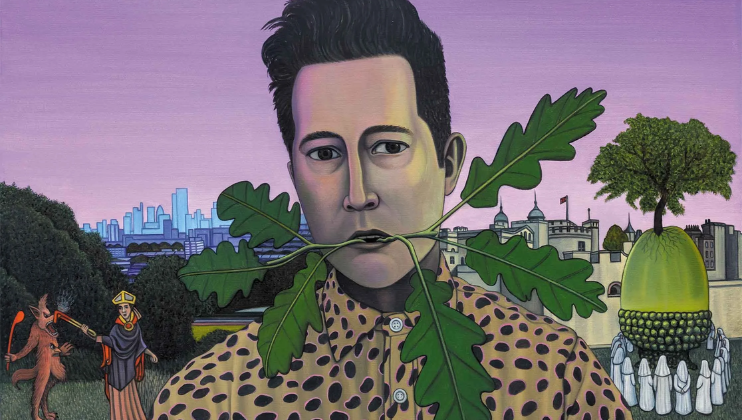Interview: artist Ben Edge
Ben Edge is a British artist working in London, whose work draws inspiration from regional folklore traditions. His exhibition 'Children of Albion' is on at Fitzrovia Chapel until 6 December 2025

What's your story, Ben? How did you come to be doing this kind of work?
Art has been part of my life since childhood, but about ten years ago I went through a very dark period. I was struggling with depression and feeling lost about where my life was headed. One day, while walking through Tower Hill, I stumbled across a Druid ceremony by complete accident.
They were performing a spring equinox ritual, honouring the moment when day and night sit in perfect balance before the days grow brighter. It hit me like a metaphor for my own life, and something shifted.
That moment opened up a whole world of folklore, ritual and community traditions. I began researching, travelling around Britain, and finding endless artistic inspiration. I started painting, making films, and for the first time I felt I’d found my true voice as an artist.
Tell us about your exhibition, 'Children of Albion'...
It brings together all the ideas I’ve been exploring over the past decade.
At the heart of the exhibition is the most ambitious painting I’ve ever made, also called Children of Albion. It spans the history and mythology of Britain from deep time to the present. I felt compelled to make it because I think we’re experiencing an identity crisis as a country, and in the face of climate change we need to understand who we are—light and dark.
The work looks directly at our colonial past, the Enclosure Acts, and even our forms of self-colonisation. But it also tries to offer a healing message, something that sparks conversations about how we move forward with honesty and hope.
The setting—Fitzrovia Chapel—is extraordinary. How does the space shape the exhibition?
It’s incredibly special. I genuinely feel like I’m collaborating with the architecture. Fitzrovia Chapel is stunning: the gold ceiling, the Christian iconography, the sense of sacredness. Even without art in it, people come just to experience the space.
When I show work, I always want to collaborate with the location. Here, my paintings sit among symbols of myth and belief, which is perfect because I’m looking at what’s sacred in our own cultural history—standing stones, rituals, the stories that shape us.
Churches are being repurposed now as their original function becomes less central to daily life, but their sense of the sacred remains—just like ancient stone monuments long after the rituals around them ended. Exhibitions in churches allow people to step out of their everyday lives, and I hope this show gives visitors that same shift in perspective.
What does London mean to you?
My roots are very London. My granddad worked at Smithfield’s Meat Market and my dad is a proper Londoner. My parents separated when I was young so I grew up in Kent, but I spent weekends here and moved to London full-time when I was 18 or 19.
What I love about London is its character. It’s a city that constantly tears itself down and rebuilds, but the layers of history remain. When I was a kid visiting Shoreditch with my dad, we’d walk to Spitalfields Market past Jack-the-Ripper-style streets, new glass towers, Roman walls—everything happening at once.
I still feel that way. I love the blue plaques, the diversity, the fact you can eat food from every corner of the world on one street, and that you can access the best art and exhibitions whenever you want. London is in my heart.
I wander a lot, and the city constantly surprises me. It's that mix of old and new, the way the whole history of London feels present at once, that inspires me.
What culture is calling you?
Growing up, I struggled to understand what “British culture” actually meant. There’s the obvious national imagery, but for me the real treasure lies in regional culture.
Every county has its own traditions, crafts, rituals—its own creativity. That’s what fascinates me. I sometimes think we should be called the “United Regions” because it’s the collective tapestry of all those local cultures that makes this country what it is.
When you travel around Britain and look closely at its folk heritage, you find endless diversity within one island.